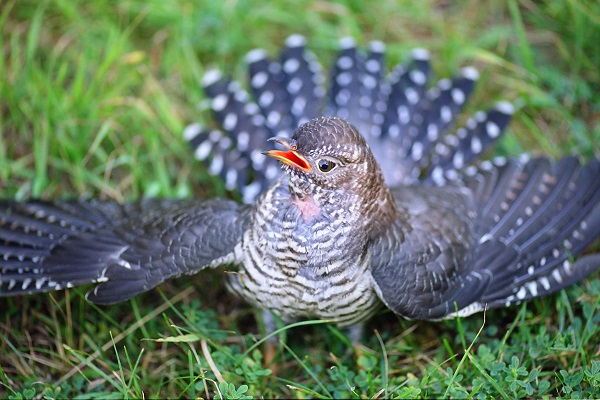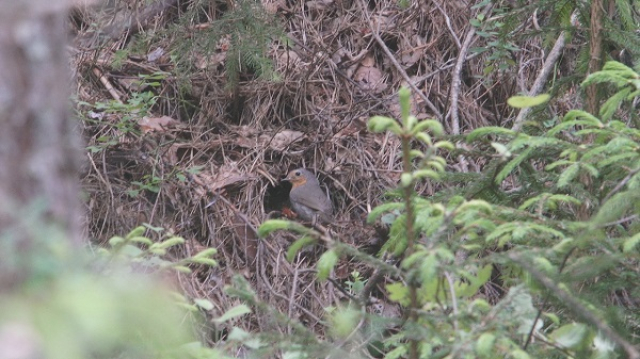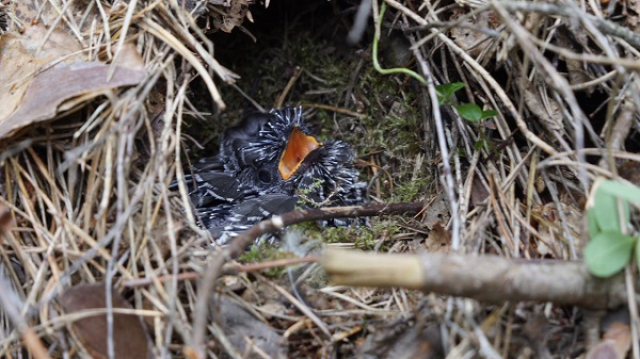
In the forest, the cuckoo’s song is always easy to hear and recognize. The naturalist Ilmārs Tīrmanis explains more about the vibrant singer.
Even though cuckoos are easy to hear, catching a glimpse of them can be quite difficult. Thus, it is worth reminding about the bird’s appearance. A cuckoo is approximately the size of a wood pigeon, slim, with a lengthy tail and long, pointed wings. The bird’s bottom is cross-delineated, but the surface differs from bird to bird – for all males and some females it is dark grey, while for other females it can be rustic.
Cuckooing for suitors
Male cuckoos are the first ones to arrive from tropical Africa – they get back even as early as towards the end of April. However, not all of them, just the quickest ones. In a few days, their songs can be heard – the bivocal sounds of “cuc-koo, cuc-koo”. A bit later, when female cuckoos arrive in Latvia as well, the male cuckooing can be heard quite a lot, frankly, from early mornings until late evenings. In May, cuckoos sing with their whole hearts and one male beak can make dozens of “cuckoos” in a row.
Returning from the South, every female cuckoo without any hesitation selects and occupies a particular territory it tries to protect from the competing sister species while waiting for the cuckooing songs of the potential suitors.
On the other hand, male cuckoos in spring become seekers. Every single one of them, when flying into the potential territory of a female cuckoo, sings their loud and vibrant song. Even the bird’s long tail participates in the performance, obliquely raising up and down with every syllable.
If the cuckooing stops and a sound similar to a hoarse person laughing arises, it means that the male cuckoo is worried and excited. The female cuckoo shouts loud “kui-kui-kui-kui” or “plyu-plyu-plyu-plyu” sounds, thus informing the suitor that she is coming his way. By the way, female cuckoos without any prejudice mate with numerous males in a row.
The sooner the midsummer approaches, the less the cuckoo’s voice can be heard. After the midsummer, it can be heard even more rarely until it completely disappears.
Does not raise its children
Who is still surprised that the cuckoos do not pamper their own babies? The cuckoo is the only nesting parasite or so-called kleptoparasite in Latvia. They roll the care of the baby cuckoos to smaller birds. The cuckoo babies’ foster parents can be dozens of various bird species.

Pictured: Robin at its nest with approximately a week-old baby cuckoo
Potential foster parents in Latvia are common redstart, whinchat, various warblers, acrocephalus, leaf warbler, pipit, wagtail, robin, dunnock, and some other songbirds. These bird species nest in different spots and at different times. Moreover, some species pamper their descendants even two to three times a year. Therefore, during the nesting season, the cuckoo will be able to find numerous small birds’ nests to lay her own egg.
Laying unique eggs
Nevertheless, not every nest is suitable for all cuckoos; thus, the cuckoos specialize – they lay different and particularly colored eggs. Cuckoos are classified into ecological groups based on the coloring of their eggs. Meanwhile, the egg color corresponds to the coloring of their chosen victimbirds’ eggs. There is no way for cuckoos to impact or change the color of their eggs, and every cuckoo will have the same colored eggs throughout her life.
Cuckoos’ eggs are relatively small in comparison to cuckoos’ size in order not to significantly differ from the small birds’ eggs.
Careful nest monitoring
To find a suitable small bird’s nest, the cuckoo firstly patiently seeks the birds themselves and then secretly monitors them to find her next place where to lay eggs. Afterward, the cuckoo waits for a short but severely important moment – when the chosen nest is full of the rightful owners’ eggs, but they are not hatched yet.
Female cuckoos can lay ten to twenty eggs during one season. The large number is needed to make up for the significant number of failure events.
Secretive laying
In every chosen nest, the cuckoo leaves only one egg. She literally “tricks” the egg into the nest, because no bird will allow her to do so openly. The female cuckoo is often unable to perform this task on her own; thus, often one or more male cuckoos come to help and divert the small birds away. With the small birds being elsewhere, the cuckoo secretly flies to the nest and lays her egg in a few seconds’ time. If necessary, she can also find another solution – lay the egg on the ground, take it in her beak, fly to the nest, and leave the egg there. Right afterward, before flying away, the cuckoo steals one owners’ egg and eats or throws it away. That way the number of eggs in the nest remains unchanged and the songbirds do not notice that a cuckoo has visited the nest during their absence.
Detailed calculations
But why do the cuckoos lay only a single egg in a different nest and then search for another place rather than laying all eggs in the same victim nest? Because only one, the first-hatched, baby cuckoo would remain in the nest anyway. Just a few hours after hatching, it would use its undeveloped wings to roll the other eggs or baby birds on its back and throw them out of the nest. Baby brothers and sisters, the owners’ descendants, both in eggs and recently hatched, are thrown over the edge.
Cuckoos’ descendants develop in the egg for a shorter time than the onwers’ descendants. A baby cuckoo usually hatches after almost two weeks counting from the start of incubating. Already on the first day after hatching, the blind and yet unfeathered bird starts to intuitively throw everything out of the nest until it remains alone.
The newcomer requires a lot of food
A baby cuckoo has a great appetite – it eats just as much as a whole set of small birds’ babies. To stimulate its breadwinners to bring food faster, the bird takes a particular stand, and opens the beak, that way insistently demonstrating the large, vibrantly colored throat, quivers the little wings, and tweets.

Pictured: approximately a week-old baby cuckoo in a robin’s nest
The foster parents feed their foster baby for three weeks throughout every single day. When the baby cuckoo is almost too large for the nest, to get to the sizeable bird and insert food in the open beak, the foster parents often have to sit on the bird’s back or head. They continue feeding the bird for two or three weeks also when it has learned to fly and left the nest.
The baby cuckoo becomes independent at around one and a half month of age. Then it slowly starts to make its way to the wintering place in Africa where its parents have already departed to.
An unusual situation for an LVM planner
It is definitely not easy for a human to spot a small bird’s nest in the forest. But to accidentally find a nest with a recently hatched baby cuckoo is the ultimate luck. Latvia’s State Forests senior planner Rūdolfs Tirmanis was lucky enough to experience that. He managed to find a robin’s nest with a recently hatched baby cuckoo. Next to the nest, he found four thrown-out robin’s eggs and a just hatched ) and an already frozen to death) baby.


